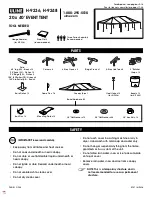
rigging for bad weather
The Opera House has three guyline attachment points so you can rig it
increasingly securely in response to actual or anticipated winds.
• Guylines should counter-balance one another for maximum stability
and minimum stress on the tent. The wall guyline attachment points
are angled toward the back of the tent to offset the forward pull of the
guyline attached to the front roof peak.
• As with any tent, a little shelter provided by trees, rock, or snow walls
will make for a quieter night’s sleep under windy conditions.
anchoring the tent
The #7001-T6 aluminum stakes included with the tent are suitable for
general use on relatively soft ground. However, in very hard-packed
ground you will need stronger (and heavier!) stakes that can withstand
the force needed to drive them in. On snow, sand, or other loosely packed
surfaces, wider T-Stakes or aluminum snow stakes will hold better; these
stakes hold best buried horizontally. You can also improvise with other
“stakes” (hiking staffs, ice axes, branches, rocks, trees), using the tent’s
stake loops or cord as required.
When packing for your trip, consider the conditions you’ll likely encounter
and what sort of anchors you’ll require. You can often leave several of
the supplied pegs at home and replace them with improvised anchors,
thereby saving weight and space in your pack.
Ventilating the tent
Proper ventilation is the key to minimizing condensation in any tent. Keep
fabric doors open as widely as the prevailing weather permits. If bugs or
drafts aren’t a problem, leave mesh doors open as well. Crack each door
open from the top down; warm, moist air rises and will escape through
high openings. If the design of your tent allows for it, have openings at
both ends or both sides of the tent to allow air to flow through for best
ventilation. On very hot nights, when you are confident there will be no
rain or dewfall, you can leave the flysheet off and use the inner tent alone
as a “bug tent.”
Содержание Opera House 2
Страница 7: ......

























